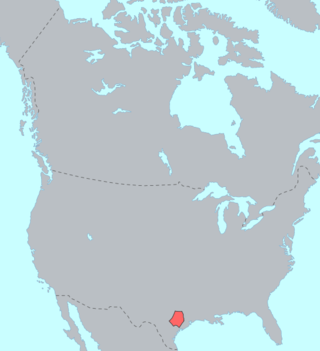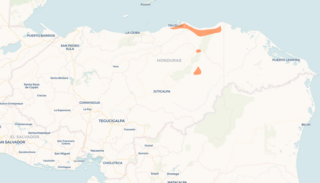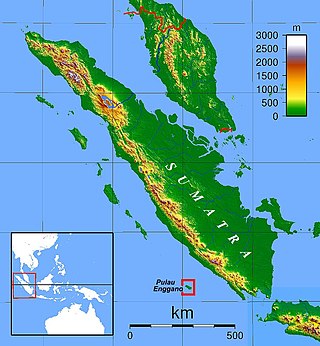Related Research Articles
The Ho-Chunk language, also known as Winnebago, is the language of the Ho-Chunk people of the Ho-Chunk Nation of Wisconsin and Winnebago Tribe of Nebraska. The language is part of the Siouan language family and is closely related to other Chiwere Siouan dialects, including those of the Iowa, Missouria, and Otoe.

Crow is a Missouri Valley Siouan language spoken primarily by the Crow Nation in present-day southeastern Montana. The word Apsáalooke translates to "Children of the Large Beaked Bird", which was later incorrectly translated into English as 'Crow'. It is one of the larger populations of American Indian languages with 4,160 speakers according to the 2015 US Census.

The Tonkawa language was spoken in Oklahoma, Texas, and New Mexico by the Tonkawa people. A language isolate, with no known related languages, Tonkawa has not had L1 speakers since the mid 1900s. Most Tonkawa people now only speak English, but revitalization is underway.

Tuscarora, sometimes called Skarò˙rə̨ˀ, was the Iroquoian language of the Tuscarora people, spoken in southern Ontario, Canada, North Carolina and northwestern New York around Niagara Falls, in the United States, before becoming extinct in late 2020. The historic homeland of the Tuscarora was in eastern North Carolina, in and around the Goldsboro, Kinston, and Smithfield areas.

Eastern Pomo, also known as Clear Lake Pomo, is a nearly extinct Pomoan language spoken around Clear Lake in Lake County, California by one of the Pomo peoples.
Tübatulabal is an Uto-Aztecan language, traditionally spoken in Kern County, California, United States. It is the traditional language of the Tübatulabal, who still speak the traditional language in addition to English. The language originally had three main dialects: Bakalanchi, Pakanapul and Palegawan.
Pohnpeian is a Micronesian language spoken as the indigenous language of the island of Pohnpei in the Caroline Islands. Pohnpeian has approximately 30,000 (estimated) native speakers living in Pohnpei and its outlying atolls and islands with another 10,000-15,000 (estimated) living off island in parts of the US mainland, Hawaii and Guam. It is the second-most widely spoken native language of the Federated States of Micronesia the first being Chuukese.

Aguaruna is an indigenous American language of the Chicham family spoken by the Aguaruna people in Northern Peru. According to Ethnologue, based on the 2007 Census, 53,400 people out of the 55,700 ethnic group speak Aguaruna, making up almost the entire population. It is used vigorously in all domains of life, both written and oral. It is written with the Latin script. The literacy rate in Aguaruna is 60-90%. However, there are few monolingual speakers today; nearly all speakers also speak Spanish. The school system begins with Aguaruna, and as the students progress, Spanish is gradually added. There is a positive outlook and connotation in regard to bilingualism. 50 to 75% of the Aguaruna population are literate in Spanish. A modest dictionary of the language has been published.

The Nukak language is a language of uncertain classification, perhaps part of the macrofamily Puinave-Maku. It is very closely related to Kakwa.
Taos is a Tanoan language spoken by several hundred people in New Mexico, in the United States. The main description of its phonology was contributed by George L. Trager in a (pre-generative) structuralist framework. Earlier considerations of the phonetics-phonology were by John P. Harrington and Jaime de Angulo. Trager's first account was in Trager (1946) based on fieldwork 1935-1937, which was then substantially revised in Trager (1948). The description below takes Trager (1946) as the main point of departure and notes where this differs from the analysis of Trager (1948). Harrington's description is more similar to Trager (1946). Certain comments from a generative perspective are noted in a comparative work Hale (1967).
Leti is an Austronesian language spoken on the island of Leti in Maluku. Although it shares much vocabulary with the neighboring Luang language, it is marginally mutually intelligible.

Pech or Pesh is a Chibchan language spoken in Honduras. It was formerly known as Paya, and continues to be referred to in this manner by several sources, though there are negative connotations associated with this term. It has also been referred to as Seco. There are 300 speakers according to Yasugi (2007). It is spoken near the north-central coast of Honduras, in the Dulce Nombre de Culmí municipality of Olancho Department.

The Enggano language, or Engganese, is an Austronesian language spoken on Enggano Island off the southwestern coast of Sumatra, Indonesia.
Warndarrang (waɳʈaraŋ), also spelt Warndarang, Wanderang, Wandaran, and other variants is an extinct Aboriginal Australian language in the Arnhem family, formerly spoken by the Warndarrang people in southern Arnhem Land, along the Gulf of Carpentaria. The last speaker was Isaac Joshua, who died in 1974, while working with the linguist Jeffrey Heath.
Maia is a Papuan language spoken in the Madang Province of Papua New Guinea, and is a member of the Trans-New Guinea language family. It has a language endangerment status of 6a, which means that it is a vigorous and sustainable language spoken by all generations. According to a 2000 census, there are approximately 4,500 living speakers of the language, who are split between twenty-two villages in the Almani district of the Bogia sub-district.
Wandala, also known as Mandara or Mura', is a language in the Chadic branch of the Afro-Asiatic language family, spoken in Cameroon and Nigeria.
Wamesa is an Austronesian language of Indonesian New Guinea, spoken across the neck of the Doberai Peninsula or Bird's Head. There are currently 5,000–8,000 speakers. While it was historically used as a lingua franca, it is currently considered an under-documented, endangered language. This means that fewer and fewer children have an active command of Wamesa. Instead, Papuan Malay has become increasingly dominant in the area.
Maskelynes, or Kuliviu (Uliveo), is an Oceanic language spoken on the Maskelyne Islands off south Malekula, Vanuatu.

Matlatzinca, or more specifically San Francisco Matlatzinca, is an endangered Oto-Manguean language of Western Central Mexico.[3] The name of the language in the language itself is pjiekak'joo.[4] The term "Matlatzinca" comes from the town's name in Nahuatl, meaning "the lords of the network." At one point, the Matlatzinca groups were called "pirindas," meaning "those in the middle."[5]
The phonology of Māori is typical for a Polynesian language, with its phonetic inventory being one of the smallest in the world with considerable variation in realisation. The Māori language retains the Proto-Polynesian syllable structure: (C)V(V ), with no closed syllables. The stress pattern is unpredictable, unlike in many other Polynesian languages.
References
- ↑ Southeast Babar at Ethnologue (18th ed., 2015) (subscription required)
- ↑ Taber, Mark (1993). "Toward a better understanding of the Indigenous Languages of Southwestern Maluku". Oceanic Linguistics. 32 (2): 389–441. JSTOR 3623199.
- 1 2 Steinhauer, Hein (2009). The sounds of Southeast Babar. Adelaar, K. Alexander and Pawley, Andrew (eds.), Austronesian historical linguistics and culture history: a festschrift for Robert Blust: Canberra: Research School of Pacific and Asian Studies, Australian National University. pp. 399–409.